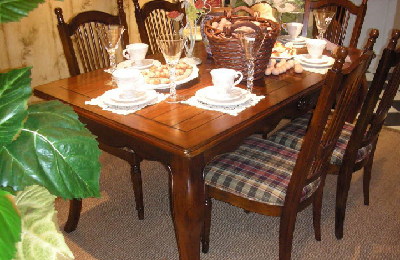During a banquet, there are serving and eating etiquettes.
Serving Etiquettes
Serving etiquettes are mainly about where and how to place a dish. Also, clearly stipulated are matters such as the direction in which a dish points, how a steward should hold a dish and where a main course is placed. When serving, the steward balances a dish on his left palm with the right hand assisting.

The meal normally starts with a set of about four cold dishes, then to be followed by the main courses of hot meat and vegetable dishes. Soup then will be offered (unless in Guangdong style restaurants) to be followed by staple food ranging from rice, noodles to dumplings. If you wish to have your rice to go with other dishes, you should say so in due time, for most of the Chinese prefer to have the staple food at last or have none of them at all.
When hosts place dishes on the table, they will arrange the main courses at the center with the supporting dishes evenly placed around them. When the main dishes are prepared in a decorative form either by cut or other means they will be placed facing the major guests and elder people at the table. This also embodies virtue.
The direction of a dish is considered particularly important when serving a whole fish. Usually the tail is placed toward the most honored guest because of its being easier to pick meat off the bone from the lower part. In winter, however, the fish fresh at the stomach is tender and rich, so this side is placed toward the honored guest. In summer the best part is its back.
Eating Etiquettes
A major aspect of eating etiquettes is respect for seniority and superiority -- children for their parents, subordinates for their superiors, younger for older, and host for guest. It is reflected not only in order of seating, but also in eating. Eating usually begins in order of seniority, with each diner taking the cue to start from his or her immediate superior.

There are also many detailed norms of conduct to observe during a banquet or big family meal. For example, the practice of presenting the best or fine food first to the senior members of the family has been observed for countless generations. When honored guests arrive, other guests would stand up to show their respect. Before starting to eat dinner, the host may offer some words of greeting.
Usually it is polite to start to eat after the host makes a toast and invites guests to help themselves to the dishes, and the guests would express their thanks. When the host invites a guest to help himself to a particular dish, the guest would always gratefully take some, and never dream of declining.
There are also many prescribed eating taboos regarding gulping, pouring, slurping, and picking teeth during a meal.
Seating Arrangement
In the traditional seating arrangement, the left or eastward side is considered most honorable, the seat facing the door most venerable of all. The second most prestigious seat is opposite the first, the third is adjacent to the first seat. And the fourth seat is next to the second.

When all are seated, the host would make a toast and invite guests to help themselves to the dishes, and the guests would express their thanks. After the banquet, the guests are again ushered into the sitting room to have tea until it is time to leave.










